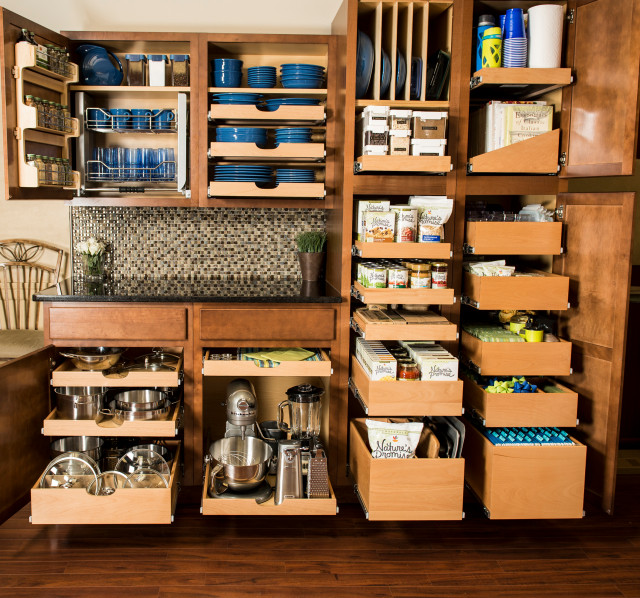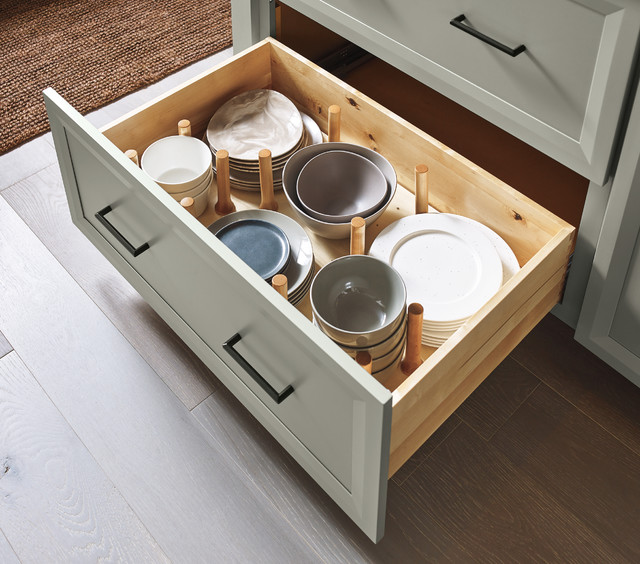Declutter First
I recommend decluttering items you no longer want or need before you reorganize or remodel your kitchen. Cluttered cabinets may be deterrents for putting things away properly, which can then contribute to your kitchen running inefficiently.
While you’re decluttering, take note of the items that remain. Think about what you use most often and be sure to reserve prime spots for them. Sort your items into categories: cooking utensils, baking tools, food storage containers and bags, seasonal items and so on.
Each of your kitchen categories will need housing, preferably in separate, dedicated spaces. Consider which categories are used most frequently, such as flatware, plates and mugs, so you can store those items within easy reach. Remember to also take into account proximity to your dishwasher. For example, a prime cabinet that’s close to the dishwasher may be best for storing relatively heavy plates and bowls.
Visualize Your Kitchen Goals
Next, consider what your vision is for your kitchen. Do you want all of your counters to be completely clear of items? Or do you not mind storing some items in plain view (such as a utensil canister, oils and coffee pods)?
The size of your kitchen and the items you choose to keep may be determining factors in your vision. I have a small kitchen; to keep my counters as clear as possible, I opted to get rid of certain items (one-purpose tools such as a strawberry huller had to go) so that the remaining items would comfortably fit in my drawers.
Additionally, it may be worth it to measure some of your items. Flatware is usually quite standard in length and width and can typically fit in off-the-rack flatware trays. However, some specialized cooking utensils may be oddly sized or shaped. Some categories may not need much space, and you may be able to maximize your storage and corral these into smaller, size-appropriate containers.
Basic Improvements
You can set up your kitchen so everything has its designated place without too much investment. After taking some basic measurements of your items and your drawer and shelf dimensions, assess your cabinet setup and determine your plan of where to put things.
Adjust shelves.
If the shelves are adjustable, take advantage of that flexibility and change the heights as necessary. It’s possible to gain extra space simply by changing the original shelf heights. I’ve often recommended getting additional shelves to maximize storage. Even a few inches may be quite helpful for storing placemats or shallow platters.
When deciding the heights to set each shelf, be sure to leave enough clearance so that retrieving items will be easy. It won’t be as efficient if you have to remove the items in front to reach the items in the back of a cabinet. For example, if you’re storing spices, be sure to set the shelf height so you can easily reach and remove spices from the back without disturbing the ones in front.
Place organizers in drawers and cabinets.
The cost to outfit your kitchen with containers can vary widely, but most homeowners can find solutions for their budget. First, consider the type of material you’d like, such as glass or bamboo. Plastic containers offer the most shape and size options.
Sourcing containers can range from no-cost (repurposing current containers, such as snack containers, food storage containers, pasta sauce jars) to low-cost (containers from discount stores) to mid- or high-cost (containers from specialty organization stores).
I like all of my containers to match or complement one another, so I will always strive for that goal whether they are no-cost or high-cost. Functionality does take high priority, however, and I may introduce a few rogue pieces if necessary.
Prioritize everyday items.
To create more space for everyday items, consider which pieces are used only occasionally or seasonally. These items don’t need to take up permanent real estate in your kitchen.
For example, holiday platters could be stored with your other holiday items. If you use the roasting pan only for Thanksgiving, you can consider packing up the pan along with any accessories you use only during that time, such as a turkey baster or fat separator.
By removing occasional-use items from your main kitchen area, you may be able to better organize your space and focus on higher-priority categories.
Midrange Improvements
If you’re not ready for a full remodel but would like to make some impactful changes, consider all the places in your kitchen that aren’t performing to their full potential.
The blind corner cabinet is often a prime example. It can be a big hole where things get lost and forgotten — and retrieving an item can be quite ungraceful. There are many options to resolve this inefficient space, such as spin-out shelves, lazy Susans and corner drawers.

I’m a fan of pullout shelves, even for cabinets that aren’t in the corner. I like the ease of pulling out a shelf and plucking what I need without disrupting other items. It’s also much more convenient to not have to reach far into the back of a deep cabinet.
Pullout shelves could also reduce household waste, because you’ll see everything each time you pull the shelf out and may be less likely to forget or lose items. This might not be a concern if you have shallow cabinets, but I find them to be effective for deeper cabinets.
Do note that you’ll lose some width and height by adding pullout shelves, as you’ll need clearance for the shelf and there will inevitably be hardware that takes up space.Paris CohenConsider a sliding tray. You might consider adding a sliding tray to create a double drawer if you have extra vertical space in your drawers. This would involve installing rails and a tray to slide on top of the existing drawer.
Besides increasing the storage space in your drawers, this can be a great option for separating flatware, organizing container or pot lids or organizing things like plastic wrap, aluminum foil and food storage bags. Pullout shelves and sliding drawer trays are readily available online and require installation.
Add an island.
Consider adding a freestanding island or custom kitchen island if you need more storage or counter space and your floor plan allows. This solution can range from a simple ready-made piece to a more involved custom design.
A smaller off-the-rack island may be a good temporary solution if a full remodel is on the horizon. If you aren’t planning for a remodel but need more efficient space, a more elaborate custom island may be the answer, potentially avoiding a full remodel down the road.
Midrange improvements come with more involved installations and likely require the help of a professional. A general contractor who subcontracts with a plumber and electrician, if needed, would be the first step in designing, building and installing a custom island. A contractor can also help install other shelf and cabinet improvements.

If your kitchen is falling short on functionality or general style and if your budget allows, a kitchen remodel may be what you need. A full remodel, or even a small renovation, can be a huge undertaking in time and expense. This is an opportune time to meticulously plan your new kitchen and carefully select all the details. Your kitchen design should support how you and your family work and move in the space.
Assess your preferences and lifestyle.
Consider taking note of all the tasks you perform in the kitchen and how frequently you do them. For example, do you use your stand mixer often? If so, you may want to consider incorporating an appliance lift, if you have the space, so you don’t have to carry the heavy mixer every time you use it. Plates and bowls don’t necessarily have to go in upper cabinets. If it flows better to store them in lower cabinets, your design may include a drawer with pegs to separate stacks of plates and bowls.
Look beyond the kitchen.
When designing your kitchen to be more efficient, you may want to look beyond just the kitchen itself for storage. An architect may be able to find and build out unused spaces in other areas to create more room.
Several years ago, we made the decision to convert our wood-burning fireplace into a large storage space. We never used our fireplace and also didn’t want to contribute to air pollution. The finished fireplace cavity in this photo is large enough to house all the appliances I don’t want on the counter, in addition to storing party supplies, a baking cart, sewing cart and folding ladder (for reaching items on the upper shelves).
Of course, removing a fireplace is a big decision that not everyone is ready or willing to make. But there may be other spaces that can be carved out for storage, such as below a staircase. Be sure to work with a general contractor, architect or structural engineer if you want to remove any walls or cut into any spaces to ensure that everything is designed and completed correctly.
Fully customize the space for your needs.
I’ve seen many homes with inadequate pantry space. If this is your situation, consider whether there are spaces near the kitchen that can be converted for more storage.
When one of our clients built a house, my business partner and I assessed all of our client’s needs and habits (family of four with two young children and potential for more; fresh food purchased regularly; not much to freeze; lots of activities; lots of on-the-go snacks). Based on our review of the client’s habits, we determined that a full-size refrigerator and smaller undercounter freezer would be sufficient for their needs, especially since they were installing an additional full-size refrigerator and freezer in the garage.
Therefore, we recommended that an empty cavity be built out into a small walk-in pantry. We worked with the architect and contractor to ensure we were designing within their constraints. We designed the pantry to have a counter for small appliances, such as a coffee maker, blender and toaster, so those wouldn’t have to reside visibly on the main counters. Pullout shelves and open cabinets provided plenty of room to store baking ingredients, canned food, grocery bags, holiday baking dishes and platters, cereal, children’s snacks and more.

Recent Comments